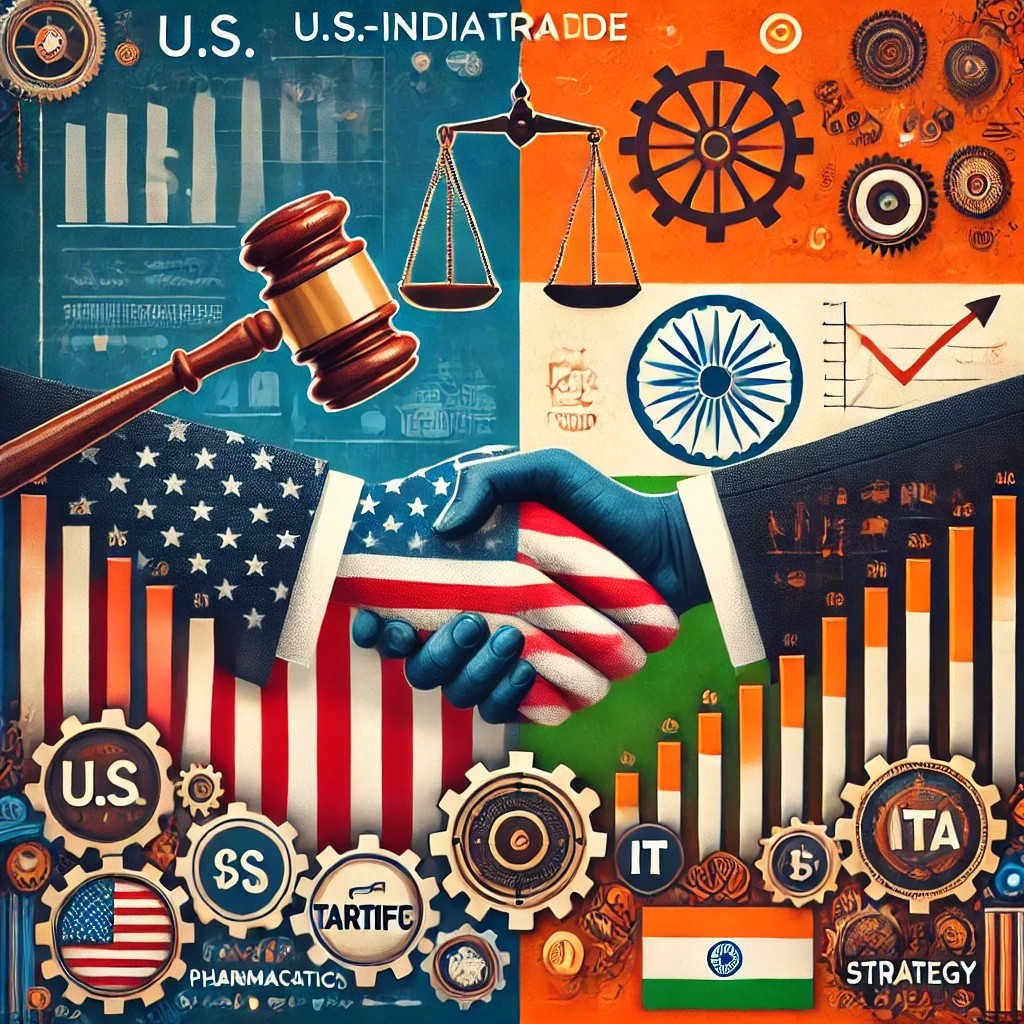The re-election of Donald Trump has reignited global trade tensions, with India emerging as a primary target under his “Reciprocal Tariff Policy.” This policy mandates that countries imposing higher tariffs on U.S. goods will face equivalent tariffs on their exports to the U.S. Given India’s relatively high tariff structure, this move could significantly impact multiple sectors, stock markets, foreign institutional investments (FIIs), and the Indian rupee.
Understanding Trump’s Reciprocal Tariff Policy
- The policy aims to reduce the U.S. trade deficit and encourage domestic manufacturing.
- Countries with higher tariffs on U.S. goods will see matching U.S. tariffs on their exports.
- India, with an average import tariff of 9.5% on U.S. goods compared to the 3% U.S. tariff on Indian goods, is among the biggest targets.
Key Examples of Tariff Disparities:
- Motorcycles (Harley-Davidson): India – 100% | U.S. – 2.4%
- Medical Devices: India – Up to 40% | U.S. – 0-5%
- Alcohol (Bourbon Whiskey): India – 150% | U.S. – 0%
Now, with Trump’s policy in effect, the U.S. will impose higher tariffs on Indian exports to match these numbers.
Indian Sectors at Risk
If the U.S. enforces reciprocal tariffs, several key Indian export industries will face challenges:
1. Textiles & Apparel
- $8 billion in annual exports to the U.S.
- Companies affected: Raymond, Arvind, Welspun India
2. Pharmaceuticals
- The U.S. is India’s largest pharma buyer (~$7 billion trade)
- Companies affected: Sun Pharma, Dr. Reddy’s, Cipla, Biocon
3. IT Services
- Over 40% of revenue for Indian IT firms comes from the U.S.
- Companies affected: Infosys, TCS, Wipro, HCL Tech
4. Jewelry & Gems
- India exports $10 billion worth of gems and jewelry to the U.S. annually.
- Higher tariffs could impact gold, diamond, and gemstone exports.
5. Auto Components & Steel
- Potential 25% tariff hike on Indian auto components.
- Companies affected: Tata Motors, Bharat Forge, Motherson Sumi
Impact on the Indian Stock Market
U.S.-India trade tensions could introduce bearish sentiment in Indian equities. While export-heavy sectors may see a downturn, domestic-oriented industries might benefit.
Likely Negative Impact:
- Textile & Apparel: Raymond, Arvind, Welspun India
- Pharma: Sun Pharma, Dr. Reddy’s, Cipla, Biocon
- Auto Components: Tata Motors, Bharat Forge, Motherson Sumi
- IT Services: Infosys, TCS, Wipro, HCL Tech
Likely Beneficiaries:
- Defense & Domestic Infra: BEL, L&T, BHEL (as India boosts self-reliance)
- Agri & Dairy: Amul, Britannia (if U.S. food imports get costlier)
- Energy & Oil Companies: Reliance, ONGC (as India imports more U.S. energy)
Foreign Institutional Investors (FIIs) Response
FIIs are highly sensitive to U.S.-India trade developments. Their reactions may include:
- Exit from export-heavy stocks (Pharma, IT, Auto Components).
- Shifting investments to other emerging markets like China, Vietnam, or the U.S.
- Reducing overall Indian equity exposure, leading to NIFTY corrections.
However, if India negotiates a favorable deal, FIIs may stay invested and look for opportunities in defense, domestic consumption, and energy sectors.
India’s Strategic Countermeasures
PM Narendra Modi’s government is taking proactive steps to mitigate the impact:
- Lowering tariffs on select U.S. products (e.g., whiskey, almonds, defense imports).
- Increasing energy imports from the U.S. (oil, LNG) to balance trade.
- Engaging in trade negotiations to secure exemptions or phased implementations.
- Exploring alternative markets (Europe, UAE, ASEAN) to diversify exports.
Impact on the Indian Rupee
A weaker rupee is a possible consequence of trade tensions due to:
- FII outflows as foreign investors reduce Indian market exposure.
- Widening trade deficit, with exports potentially slowing.
- Stronger demand for USD, as investors shift to safer assets.
Opportunities Amid Challenges
Not all industries will suffer. Some sectors may emerge stronger:
- Defense: More pressure from the U.S. = India strengthens domestic manufacturing (BEL, HAL gain).
- Energy: More U.S. oil and gas imports = Reliance, ONGC gain.
- Agriculture & Dairy: If U.S. food imports become expensive, Indian brands like Britannia and ITC benefit.
India’s Atmanirbhar Bharat initiative may accelerate due to these trade barriers, encouraging local manufacturing and self-reliance.
Key Takeaways & Outlook
- Short-term challenges: Declining exports, stock market volatility, and pressure on the rupee.
- India’s response will be crucial: Negotiations, tariff adjustments, and market diversification.
- Investment strategies must adapt: A shift toward domestic consumption, defense, and energy sectors.
At Riddhi Siddhi Share Brokers, we closely monitor global trade policies and their effects on Indian markets. If you’re an investor looking to safeguard your portfolio against these uncertainties, reach out to us today for expert financial guidance.
Disclaimer
This article is for informational purposes only and should not be considered financial or investment advice. Market conditions are subject to change, and investors should conduct their due diligence before making any investment decisions. Riddhi Siddhi Share Brokers is not liable for any financial losses incurred based on this information.

